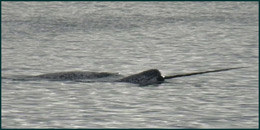Narwhal
Narwhal Sounds (Monodon monoceros)
Description

Three narwhals swimming in the high Arctic, showing their spotted skin coloration and the spiraled tusk of the middle individual. Photo courtesy of Kristin Laidre, University of Washington.
The most conspicuous feature of the narwhal is its spiraled tusk. Measuring up to 3 meters (9 feet) long, the tusk develops mostly in males as an elongated left tooth of the upper jaw. The purpose of the tusk has been debated among scientists. New research looking at fresh tusks rather than dried tissues found millions of nerves in the tusks that may be able to detect water temperature, pressure, and salinity. Narwhals are among the few whales that only inhabit Arctic waters. They are often found in the loose pack ice, moving near shore in the summer as the ice breaks up.Narwhals produce a variety of vocalizations, including echolocation clicks, tonal-pulsed signals, and whistles. The echolocation clicks have maximum frequencies of up to 160 kHz and maximum source levels of 218 underwater dB re 1 µPa. They are repeated at rates between 2 and greater than 500 per second. The tonal-pulsed signals last between 0.5 and several seconds long and range in frequency from 500 Hz to 48 kHz. The whistles typically last about 1 second and have a frequency range of 300 Hz to 48 kHz.

Side view of two narwhals swimming in the high Arctic. Photo courtesy of Kristin Laidre, University of Washington.
Additional Resources
- Scripps Institution of Oceanography, Voices in the Sea